Menispermum canadense (Canada Moonseed)
| Also known as: | |
|---|---|
| Genus: | Menispermum |
| Family: | Menispermaceae (Moonseed) |
| Life cycle: | perennial woody |
| Origin: | native |
| Habitat: | part shade, sun; moist woods, woodland edges, clearings, thickets |
| Bloom season: | May - July |
| Plant height: | 6 to 30 foot vine |
| Wetland Indicator Status: | GP: FACU MW: FAC NCNE: FAC |
| MN county distribution (click map to enlarge): |  |
| National distribution (click map to enlarge): |  |
Pick an image for a larger view. See the glossary for icon descriptions.
Detailed Information
Flower: 




![[photo of male flowers]](/udata/r9ndp23q/pd3/menispermum-canadense-16-3-t.jpg) Branching clusters up to 7 inches long arising from the leaf axils, with male and female flowers in separate clusters on the same or different plants. Flowers of both are less than ¼ inch across, somewhat bell-shaped with 4 to 9 greenish-white petals and 4 to 9 greenish-white sepals that are longer than the petals. Male flowers have a spray of 12 to 24 white stamens with yellow tips.
Branching clusters up to 7 inches long arising from the leaf axils, with male and female flowers in separate clusters on the same or different plants. Flowers of both are less than ¼ inch across, somewhat bell-shaped with 4 to 9 greenish-white petals and 4 to 9 greenish-white sepals that are longer than the petals. Male flowers have a spray of 12 to 24 white stamens with yellow tips.
![[photo of female flowers]](/udata/r9ndp23q/pd3/menispermum-canadense-16-2-t.jpg) Female flowers have 2 to 4 stout pistils with a somewhat ruffled stigma at their tips, and usually surrounded by several short, sterile stamens. Flower stalks are green and hairless to sparsely hairy with an oblong leaf-like bract at the base.
Female flowers have 2 to 4 stout pistils with a somewhat ruffled stigma at their tips, and usually surrounded by several short, sterile stamens. Flower stalks are green and hairless to sparsely hairy with an oblong leaf-like bract at the base.
Leaves and stems: 


![[photo of leaves]](/udata/r9ndp23q/pd3/menispermum-canadense-10-t.jpg) Leaves are alternate, 3 to 8 inches long and about as wide, mostly heart-shaped at the base, with 7 to 12 primary veins radiating from the base. Leaf edges are toothless and have 3 to 7 shallow lobes, the lobe tips rounded to bluntly pointed. The upper surface is medium to dark green, hairless or becoming hairless with age, the lower surface paler and finely hairy, especially along the veins.
Leaves are alternate, 3 to 8 inches long and about as wide, mostly heart-shaped at the base, with 7 to 12 primary veins radiating from the base. Leaf edges are toothless and have 3 to 7 shallow lobes, the lobe tips rounded to bluntly pointed. The upper surface is medium to dark green, hairless or becoming hairless with age, the lower surface paler and finely hairy, especially along the veins.
![[photo of leaf stalk attachment]](/udata/r9ndp23q/trees/menispermum-canadense-moonseed_0810_120636-t.jpg) Leaf stalks are up to 8 inches long and attached on the underside near but not at the base of the leaf (peltate). New stem growth is green and hairy turning reddish or purplish, woody and eventually hairless. Stems lack tendrils and twine around other vegetation for support or sprawl along the ground, and form loose colonies from spreading rhizomes.
Leaf stalks are up to 8 inches long and attached on the underside near but not at the base of the leaf (peltate). New stem growth is green and hairy turning reddish or purplish, woody and eventually hairless. Stems lack tendrils and twine around other vegetation for support or sprawl along the ground, and form loose colonies from spreading rhizomes.
Fruit: 
![[photo of ripening fruit]](/udata/r9ndp23q/pd3/menispermum-canadense-17-t.jpg) Fruit is a berry-like drupe about 1/3 inch diameter, ripening to blue-black with a white bloom, and very much resembling wild grape. Inside is a single, flat, crescent-shaped seed.
Fruit is a berry-like drupe about 1/3 inch diameter, ripening to blue-black with a white bloom, and very much resembling wild grape. Inside is a single, flat, crescent-shaped seed.
Notes:
Canada Moonseed leaves are rather variable in size and shape. The more deeply lobed leaves may resemble Wild Cucumber (Echinocystis lobata) or Wild Grape (Vitis riparia), while the less lobed leaves may resemble Bur Cucumber (Sicyos angulatus), or Wild Yam (Dioscorea villosa). Of these species, only Grape and Moonseed have woody stems. The unique leaf stalk attachment (peltate) and the single, crescent-shaped seed in the mature fruit further distinguishes Canada Moonseed from all the rest. The fruits are reportedly toxic and should not be eaten.
Native Plant Nurseries, Restoration and Landscaping Services ↓
More photos
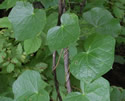 climbing Canada Moonseed
climbing Canada Moonseed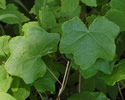 sprawling Canada Moonseed
sprawling Canada Moonseed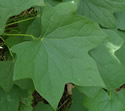 variably lobed leaves
variably lobed leaves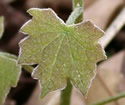 emerging in spring
emerging in spring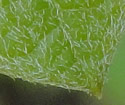 hairs on new leaves
hairs on new leaves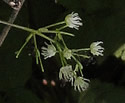 flowering stem
flowering stem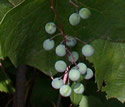 fruiting stem
fruiting stem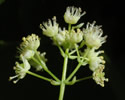 more flowers
more flowers
Photos by K. Chayka taken in Ramsey and Washington counties. Photos courtesy Peter M. Dziuk taken in Anoka and Ramsey counties.
Comments
Have you seen this plant in Minnesota, or have any other comments about it?
on: 2017-06-07 21:35:35
Found this vine in my garden growing with my clematis. Thought it was wild cuke, but after looking at your website, concluded it is moonseed. Hasn't flowered or seeded yet, but I will watch and see.
on: 2018-01-12 13:50:11
I believe this is plentiful as the Sunrise river nears the St. Croix (wooded banks, soil stays coolish). It hitches a ride up other vines if it can, but doesn't seem overly aggressive. I'll try to spot the flowering this spring.
on: 2018-06-07 19:10:38
Found some growing on state land down by the river flats around the Fort Snelling area, behind Coldwater Spring.
on: 2019-05-06 18:14:14
Have quite a bit in my yard. It's invasive. A pretty vine but only if it wouldn't spread so much and if it weren't supposed to be toxic.
on: 2019-05-06 19:29:30
Mary, many native species can be aggressive in a garden setting due at least in part to lack of sufficient competition. Vines can be a particular nuisance and may require continuous management.
on: 2019-06-11 16:21:27
I have been trying to id this vine for years. It has come through the fence from the neighbors. It can be very invasive and difficult to manage. It grows very quickly. I also have never seen the flowers but will watch for them.
on: 2019-06-12 07:40:16
We've found most native vines to be pretty aggressive in cultivation, where they compete very well with pretty much everything else. Don't feel obligated to keep it around just because it's native.
on: 2019-06-26 13:56:20
I've had a small bit of it growing in my yard for a few year., For some reason this year, it just really took off and started taking over my Lily of the Valley and Bleeding Hearts so I've had to cut it back.
on: 2019-07-09 15:49:46
Does this vine have a very strong yellow/gold root that runs underground but very shallow? A very invasive vine with exact shaped leaves is running rampant in some bushes and trees on our property.
on: 2019-07-09 18:46:09
I've read elsewhere that the roots are yellow
on: 2019-07-29 15:28:17
I carefully transplanted some, decades ago. Now.... I can't get rid of it. It merrily grows over everything, including up trees, though I haven't given it the opportunity to see how high it will go.
on: 2020-07-29 19:23:26
It's been by my door for the 29 years I've owned my place. Know now not to make jam from the succulent looking ripe berries! I just keep trimming it back and it's not a problem. Looks good too.
on: 2020-08-05 23:23:14
There is some of it along fence along the parkway between Franklin & Lake St bridges. There is a large area where it dominates, spreading eastward, at the base of the stairs down from Franklin.
on: 2021-05-18 09:21:23
In approximately 1918 my uncle died as a young child. I always assumed it was from the flu pandemic. But recently my aunt, his younger sister, told me it was from eating something they found while playing out in the fields. Another sister was very ill and they didn't expect her to survive the night, but she pulled through. An older brother, who also ate the berries, was not affected. In researching the plants in the area, I'm fairly certain they ingested the grape-like moonseed. A very sad story.
on: 2021-10-25 18:32:03
Learned today at a Tribal Relations training class that the yellow roots of this plant are the 'Yellow Medicine' used by the Dakota in the Minnesota River Valley as a skin salve are is the source of the Yellow Medicine place names in western Minnesota.
on: 2023-06-11 20:48:56
Just found this growing on the edge of my property. It can compete with the virginia creeper and grape leaves and raspberry.






